FIAT FULLBACK 2017 Owner handbook (in English)
Manufacturer: FIAT, Model Year: 2017, Model line: FULLBACK, Model: FIAT FULLBACK 2017Pages: 312, PDF Size: 12.31 MB
Page 151 of 312
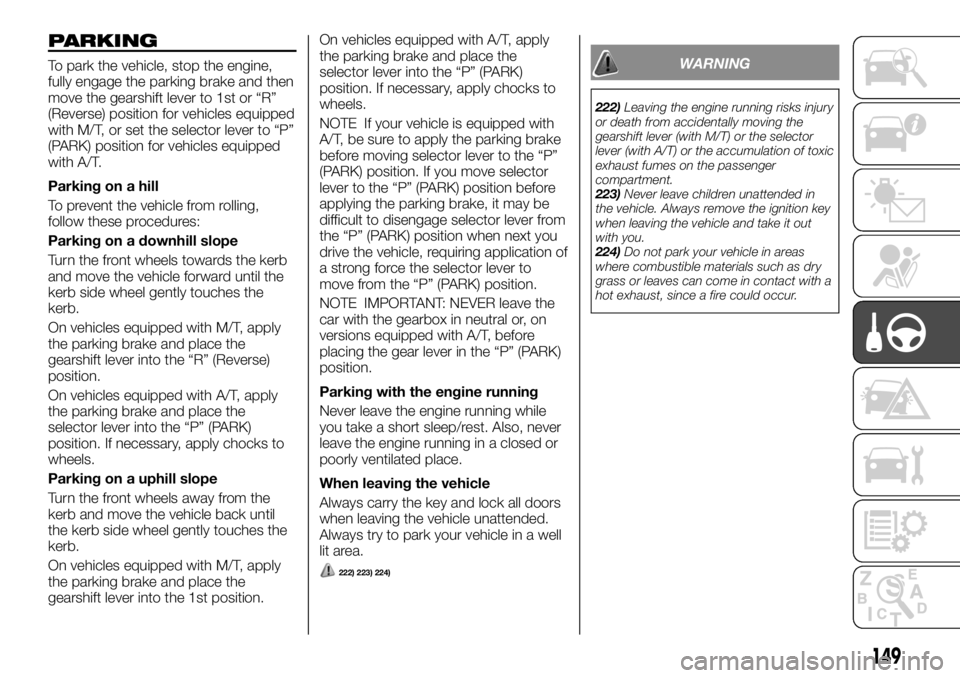
PARKING
To park the vehicle, stop the engine,
fully engage the parking brake and then
move the gearshift lever to 1st or “R”
(Reverse) position for vehicles equipped
with M/T, or set the selector lever to “P”
(PARK) position for vehicles equipped
with A/T.
Parking on a hill
To prevent the vehicle from rolling,
follow these procedures:
Parking on a downhill slope
Turn the front wheels towards the kerb
and move the vehicle forward until the
kerb side wheel gently touches the
kerb.
On vehicles equipped with M/T, apply
the parking brake and place the
gearshift lever into the “R” (Reverse)
position.
On vehicles equipped with A/T, apply
the parking brake and place the
selector lever into the “P” (PARK)
position. If necessary, apply chocks to
wheels.
Parking on a uphill slope
Turn the front wheels away from the
kerb and move the vehicle back until
the kerb side wheel gently touches the
kerb.
On vehicles equipped with M/T, apply
the parking brake and place the
gearshift lever into the 1st position.On vehicles equipped with A/T, apply
the parking brake and place the
selector lever into the “P” (PARK)
position. If necessary, apply chocks to
wheels.
NOTE If your vehicle is equipped with
A/T, be sure to apply the parking brake
before moving selector lever to the “P”
(PARK) position. If you move selector
lever to the “P” (PARK) position before
applying the parking brake, it may be
difficult to disengage selector lever from
the “P” (PARK) position when next you
drive the vehicle, requiring application of
a strong force the selector lever to
move from the “P” (PARK) position.
NOTE IMPORTANT: NEVER leave the
car with the gearbox in neutral or, on
versions equipped with A/T, before
placing the gear lever in the “P” (PARK)
position.
Parking with the engine running
Never leave the engine running while
you take a short sleep/rest. Also, never
leave the engine running in a closed or
poorly ventilated place.
When leaving the vehicle
Always carry the key and lock all doors
when leaving the vehicle unattended.
Always try to park your vehicle in a well
lit area.
222) 223) 224)
WARNING
222)Leaving the engine running risks injury
or death from accidentally moving the
gearshift lever (with M/T) or the selector
lever (with A/T) or the accumulation of toxic
exhaust fumes on the passenger
compartment.
223)Never leave children unattended in
the vehicle. Always remove the ignition key
when leaving the vehicle and take it out
with you.
224)Do not park your vehicle in areas
where combustible materials such as dry
grass or leaves can come in contact with a
hot exhaust, since a fire could occur.
149
Page 152 of 312
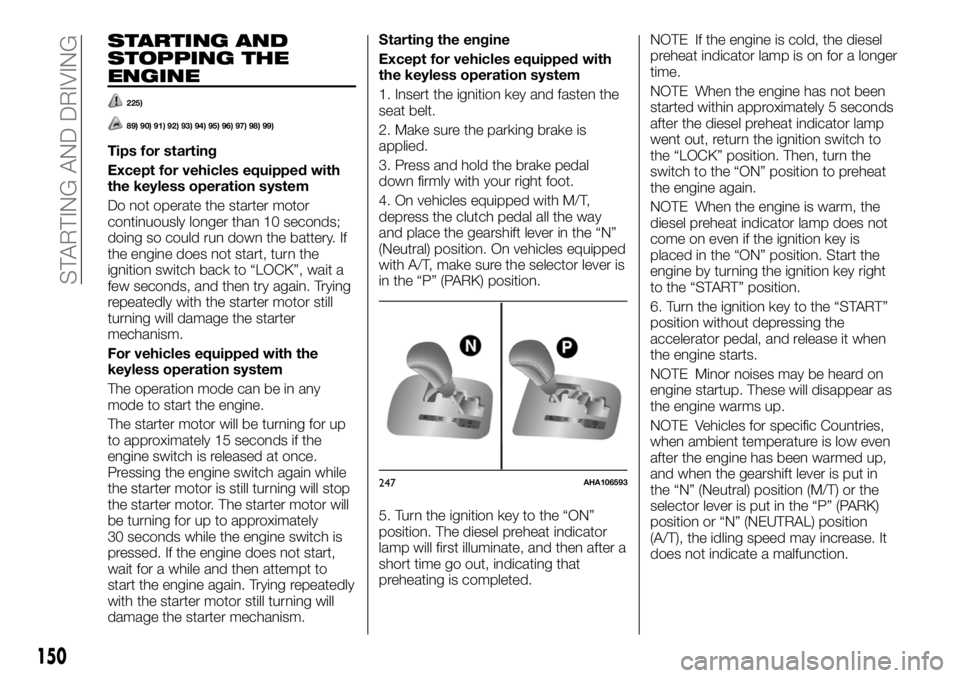
STARTING AND
STOPPING THE
ENGINE
225)
89) 90) 91) 92) 93) 94) 95) 96) 97) 98) 99)
Tips for starting
Except for vehicles equipped with
the keyless operation system
Do not operate the starter motor
continuously longer than 10 seconds;
doing so could run down the battery. If
the engine does not start, turn the
ignition switch back to “LOCK”, wait a
few seconds, and then try again. Trying
repeatedly with the starter motor still
turning will damage the starter
mechanism.
For vehicles equipped with the
keyless operation system
The operation mode can be in any
mode to start the engine.
The starter motor will be turning for up
to approximately 15 seconds if the
engine switch is released at once.
Pressing the engine switch again while
the starter motor is still turning will stop
the starter motor. The starter motor will
be turning for up to approximately
30 seconds while the engine switch is
pressed. If the engine does not start,
wait for a while and then attempt to
start the engine again. Trying repeatedly
with the starter motor still turning will
damage the starter mechanism.Starting the engine
Except for vehicles equipped with
the keyless operation system
1. Insert the ignition key and fasten the
seat belt.
2. Make sure the parking brake is
applied.
3. Press and hold the brake pedal
down firmly with your right foot.
4. On vehicles equipped with M/T,
depress the clutch pedal all the way
and place the gearshift lever in the “N”
(Neutral) position. On vehicles equipped
with A/T, make sure the selector lever is
in the “P” (PARK) position.
5. Turn the ignition key to the “ON”
position. The diesel preheat indicator
lamp will first illuminate, and then after a
short time go out, indicating that
preheating is completed.NOTE If the engine is cold, the diesel
preheat indicator lamp is on for a longer
time.
NOTE When the engine has not been
started within approximately 5 seconds
after the diesel preheat indicator lamp
went out, return the ignition switch to
the “LOCK” position. Then, turn the
switch to the “ON” position to preheat
the engine again.
NOTE When the engine is warm, the
diesel preheat indicator lamp does not
come on even if the ignition key is
placed in the “ON” position. Start the
engine by turning the ignition key right
to the “START” position.
6. Turn the ignition key to the “START”
position without depressing the
accelerator pedal, and release it when
the engine starts.
NOTE Minor noises may be heard on
engine startup. These will disappear as
the engine warms up.
NOTE Vehicles for specific Countries,
when ambient temperature is low even
after the engine has been warmed up,
and when the gearshift lever is put in
the “N” (Neutral) position (M/T) or the
selector lever is put in the “P” (PARK)
position or “N” (NEUTRAL) position
(A/T), the idling speed may increase. It
does not indicate a malfunction.
247AHA106593
150
STARTING AND DRIVING
Page 153 of 312
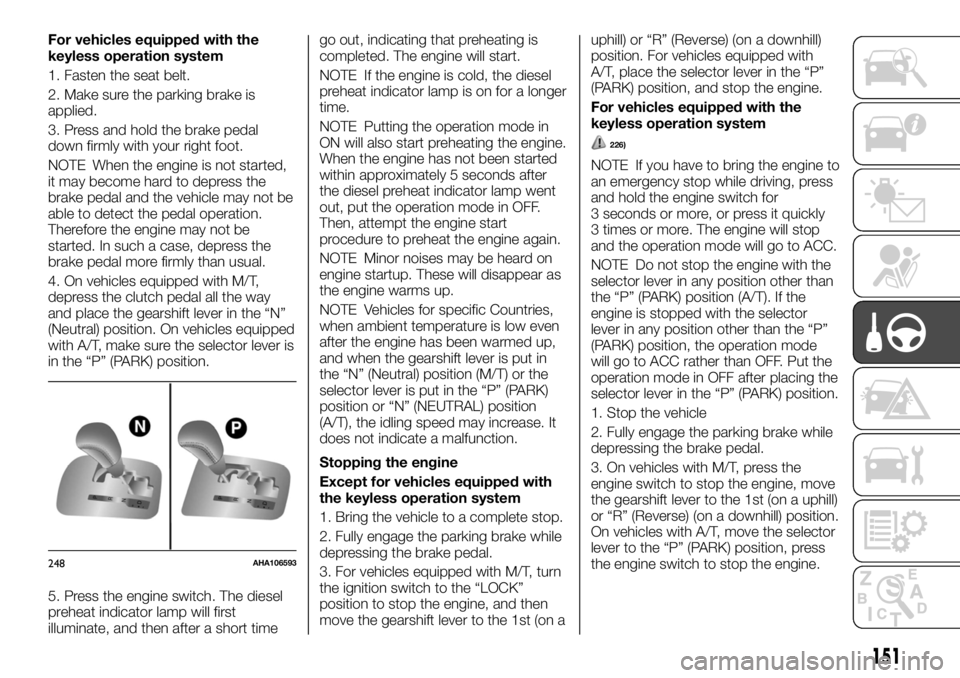
For vehicles equipped with the
keyless operation system
1. Fasten the seat belt.
2. Make sure the parking brake is
applied.
3. Press and hold the brake pedal
down firmly with your right foot.
NOTE When the engine is not started,
it may become hard to depress the
brake pedal and the vehicle may not be
able to detect the pedal operation.
Therefore the engine may not be
started. In such a case, depress the
brake pedal more firmly than usual.
4. On vehicles equipped with M/T,
depress the clutch pedal all the way
and place the gearshift lever in the “N”
(Neutral) position. On vehicles equipped
with A/T, make sure the selector lever is
in the “P” (PARK) position.
5. Press the engine switch. The diesel
preheat indicator lamp will first
illuminate, and then after a short timego out, indicating that preheating is
completed. The engine will start.
NOTE If the engine is cold, the diesel
preheat indicator lamp is on for a longer
time.
NOTE Putting the operation mode in
ON will also start preheating the engine.
When the engine has not been started
within approximately 5 seconds after
the diesel preheat indicator lamp went
out, put the operation mode in OFF.
Then, attempt the engine start
procedure to preheat the engine again.
NOTE Minor noises may be heard on
engine startup. These will disappear as
the engine warms up.
NOTE Vehicles for specific Countries,
when ambient temperature is low even
after the engine has been warmed up,
and when the gearshift lever is put in
the “N” (Neutral) position (M/T) or the
selector lever is put in the “P” (PARK)
position or “N” (NEUTRAL) position
(A/T), the idling speed may increase. It
does not indicate a malfunction.
Stopping the engine
Except for vehicles equipped with
the keyless operation system
1. Bring the vehicle to a complete stop.
2. Fully engage the parking brake while
depressing the brake pedal.
3. For vehicles equipped with M/T, turn
the ignition switch to the “LOCK”
position to stop the engine, and then
move the gearshift lever to the 1st (on auphill) or “R” (Reverse) (on a downhill)
position. For vehicles equipped with
A/T, place the selector lever in the “P”
(PARK) position, and stop the engine.
For vehicles equipped with the
keyless operation system
226)
NOTE If you have to bring the engine to
an emergency stop while driving, press
and hold the engine switch for
3 seconds or more, or press it quickly
3 times or more. The engine will stop
and the operation mode will go to ACC.
NOTE Do not stop the engine with the
selector lever in any position other than
the “P” (PARK) position (A/T). If the
engine is stopped with the selector
lever in any position other than the “P”
(PARK) position, the operation mode
will go to ACC rather than OFF. Put the
operation mode in OFF after placing the
selector lever in the “P” (PARK) position.
1. Stop the vehicle
2. Fully engage the parking brake while
depressing the brake pedal.
3. On vehicles with M/T, press the
engine switch to stop the engine, move
the gearshift lever to the 1st (on a uphill)
or “R” (Reverse) (on a downhill) position.
On vehicles with A/T, move the selector
lever to the “P” (PARK) position, press
the engine switch to stop the engine.
248AHA106593
151
Page 154 of 312
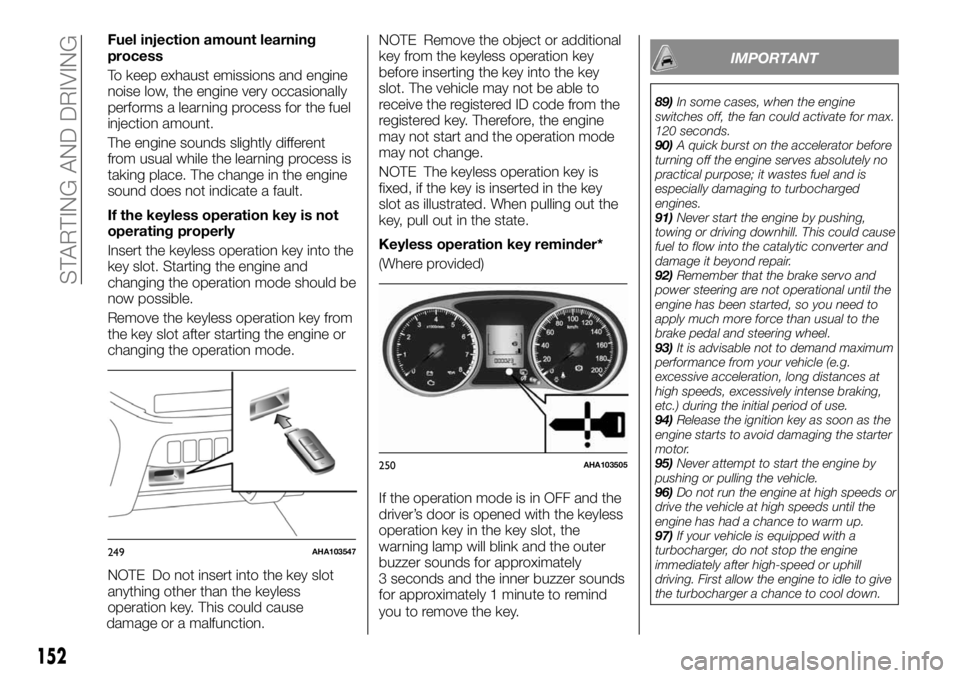
Fuel injection amount learning
process
To keep exhaust emissions and engine
noise low, the engine very occasionally
performs a learning process for the fuel
injection amount.
The engine sounds slightly different
from usual while the learning process is
taking place. The change in the engine
sound does not indicate a fault.
If the keyless operation key is not
operating properly
Insert the keyless operation key into the
key slot. Starting the engine and
changing the operation mode should be
now possible.
Remove the keyless operation key from
the key slot after starting the engine or
changing the operation mode.
NOTE Do not insert into the key slot
anything other than the keyless
operation key. This could cause
damage or a malfunction.NOTE Remove the object or additional
key from the keyless operation key
before inserting the key into the key
slot. The vehicle may not be able to
receive the registered ID code from the
registered key. Therefore, the engine
may not start and the operation mode
may not change.
NOTE The keyless operation key is
fixed, if the key is inserted in the key
slot as illustrated. When pulling out the
key, pull out in the state.
Keyless operation key reminder*
(Where provided)
If the operation mode is in OFF and the
driver’s door is opened with the keyless
operation key in the key slot, the
warning lamp will blink and the outer
buzzer sounds for approximately
3 seconds and the inner buzzer sounds
for approximately 1 minute to remind
you to remove the key.
IMPORTANT
89)In some cases, when the engine
switches off, the fan could activate for max.
120 seconds.
90)A quick burst on the accelerator before
turning off the engine serves absolutely no
practical purpose; it wastes fuel and is
especially damaging to turbocharged
engines.
91)Never start the engine by pushing,
towing or driving downhill. This could cause
fuel to flow into the catalytic converter and
damage it beyond repair.
92)Remember that the brake servo and
power steering are not operational until the
engine has been started, so you need to
apply much more force than usual to the
brake pedal and steering wheel.
93)It is advisable not to demand maximum
performance from your vehicle (e.g.
excessive acceleration, long distances at
high speeds, excessively intense braking,
etc.) during the initial period of use.
94)Release the ignition key as soon as the
engine starts to avoid damaging the starter
motor.
95)Never attempt to start the engine by
pushing or pulling the vehicle.
96)Do not run the engine at high speeds or
drive the vehicle at high speeds until the
engine has had a chance to warm up.
97)If your vehicle is equipped with a
turbocharger, do not stop the engine
immediately after high-speed or uphill
driving. First allow the engine to idle to give
the turbocharger a chance to cool down.
249AHA103547
250AHA103505
152
STARTING AND DRIVING
Page 155 of 312
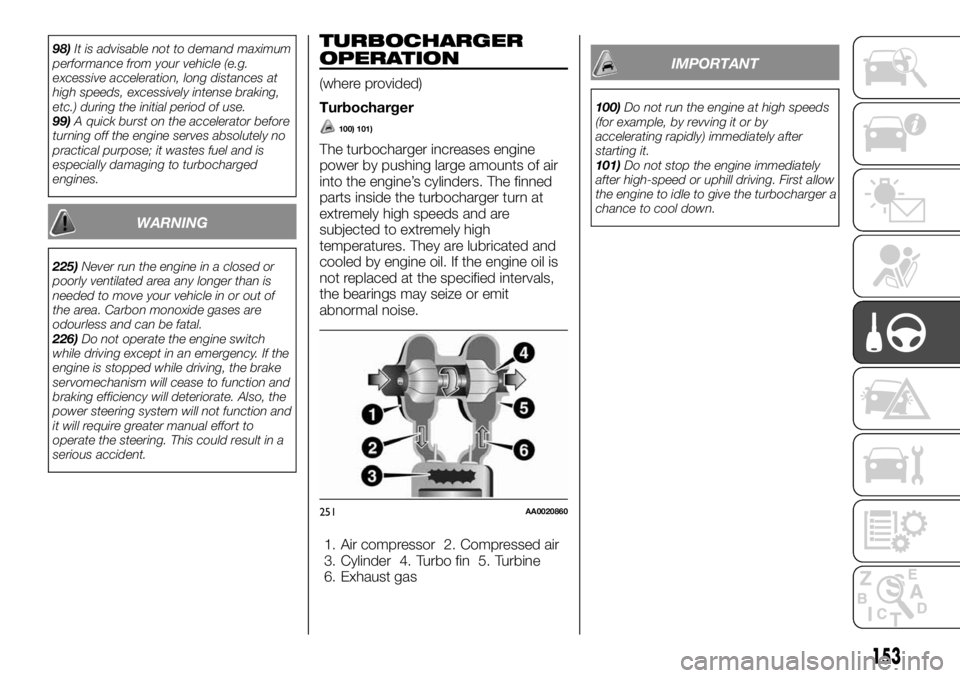
98)It is advisable not to demand maximum
performance from your vehicle (e.g.
excessive acceleration, long distances at
high speeds, excessively intense braking,
etc.) during the initial period of use.
99)A quick burst on the accelerator before
turning off the engine serves absolutely no
practical purpose; it wastes fuel and is
especially damaging to turbocharged
engines.
WARNING
225)Never run the engine in a closed or
poorly ventilated area any longer than is
needed to move your vehicle in or out of
the area. Carbon monoxide gases are
odourless and can be fatal.
226)Do not operate the engine switch
while driving except in an emergency. If the
engine is stopped while driving, the brake
servomechanism will cease to function and
braking efficiency will deteriorate. Also, the
power steering system will not function and
it will require greater manual effort to
operate the steering. This could result in a
serious accident.
TURBOCHARGER
OPERATION
(where provided)
Turbocharger
100) 101)
The turbocharger increases engine
power by pushing large amounts of air
into the engine’s cylinders. The finned
parts inside the turbocharger turn at
extremely high speeds and are
subjected to extremely high
temperatures. They are lubricated and
cooled by engine oil. If the engine oil is
not replaced at the specified intervals,
the bearings may seize or emit
abnormal noise.
1. Air compressor 2. Compressed air
3. Cylinder 4. Turbo fin 5. Turbine
6. Exhaust gas
IMPORTANT
100)Do not run the engine at high speeds
(for example, by revving it or by
accelerating rapidly) immediately after
starting it.
101)Do not stop the engine immediately
after high-speed or uphill driving. First allow
the engine to idle to give the turbocharger a
chance to cool down.
251AA0020860
153
Page 156 of 312
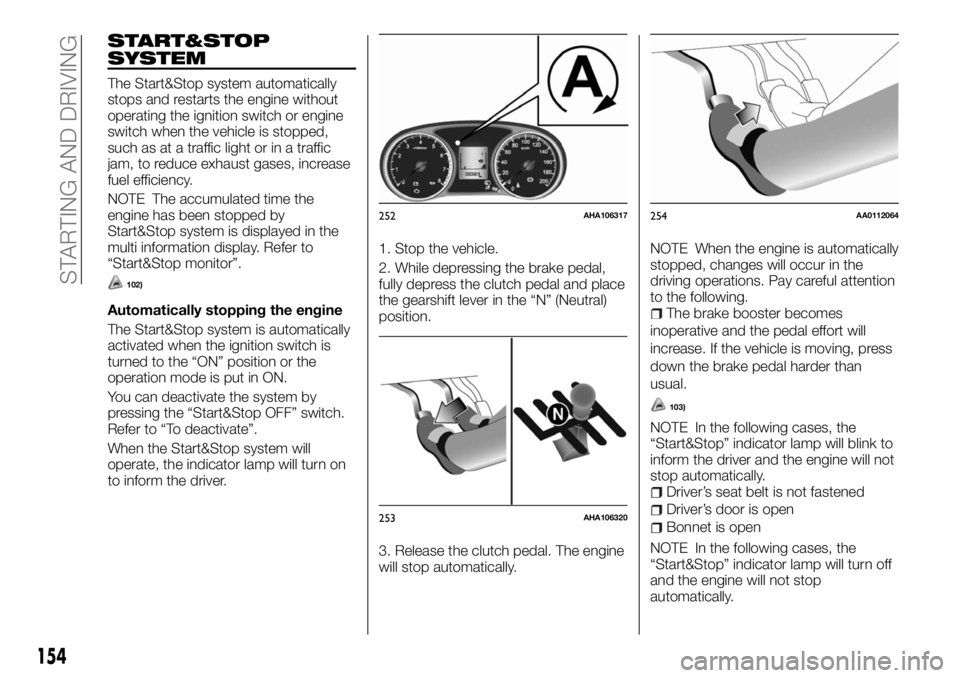
START&STOP
SYSTEM
The Start&Stop system automatically
stops and restarts the engine without
operating the ignition switch or engine
switch when the vehicle is stopped,
such as at a traffic light or in a traffic
jam, to reduce exhaust gases, increase
fuel efficiency.
NOTE The accumulated time the
engine has been stopped by
Start&Stop system is displayed in the
multi information display. Refer to
“Start&Stop monitor”.
102)
Automatically stopping the engine
The Start&Stop system is automatically
activated when the ignition switch is
turned to the “ON” position or the
operation mode is put in ON.
You can deactivate the system by
pressing the “Start&Stop OFF” switch.
Refer to “To deactivate”.
When the Start&Stop system will
operate, the indicator lamp will turn on
to inform the driver.1. Stop the vehicle.
2. While depressing the brake pedal,
fully depress the clutch pedal and place
the gearshift lever in the “N” (Neutral)
position.
3. Release the clutch pedal. The engine
will stop automatically.NOTE When the engine is automatically
stopped, changes will occur in the
driving operations. Pay careful attention
to the following.The brake booster becomes
inoperative and the pedal effort will
increase. If the vehicle is moving, press
down the brake pedal harder than
usual.
103)
NOTE In the following cases, the
“Start&Stop” indicator lamp will blink to
inform the driver and the engine will not
stop automatically.
Driver’s seat belt is not fastened
Driver’s door is open
Bonnet is open
NOTE In the following cases, the
“Start&Stop” indicator lamp will turn off
and the engine will not stop
automatically.
252AHA106317
253AHA106320
254AA0112064
154
STARTING AND DRIVING
Page 157 of 312
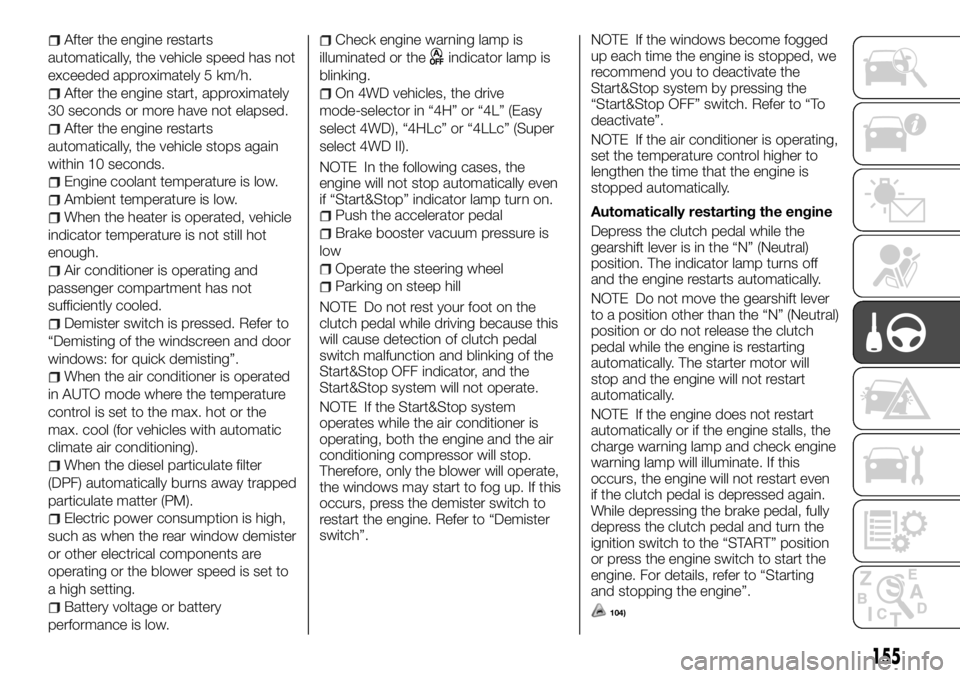
After the engine restarts
automatically, the vehicle speed has not
exceeded approximately 5 km/h.
After the engine start, approximately
30 seconds or more have not elapsed.
After the engine restarts
automatically, the vehicle stops again
within 10 seconds.
Engine coolant temperature is low.
Ambient temperature is low.
When the heater is operated, vehicle
indicator temperature is not still hot
enough.
Air conditioner is operating and
passenger compartment has not
sufficiently cooled.
Demister switch is pressed. Refer to
“Demisting of the windscreen and door
windows: for quick demisting”.
When the air conditioner is operated
in AUTO mode where the temperature
control is set to the max. hot or the
max. cool (for vehicles with automatic
climate air conditioning).
When the diesel particulate filter
(DPF) automatically burns away trapped
particulate matter (PM).
Electric power consumption is high,
such as when the rear window demister
or other electrical components are
operating or the blower speed is set to
a high setting.
Battery voltage or battery
performance is low.
Check engine warning lamp is
illuminated or the
indicator lamp is
blinking.
On 4WD vehicles, the drive
mode-selector in “4H” or “4L” (Easy
select 4WD), “4HLc” or “4LLc” (Super
select 4WD II).
NOTE In the following cases, the
engine will not stop automatically even
if “Start&Stop” indicator lamp turn on.
Push the accelerator pedal
Brake booster vacuum pressure is
low
Operate the steering wheel
Parking on steep hill
NOTE Do not rest your foot on the
clutch pedal while driving because this
will cause detection of clutch pedal
switch malfunction and blinking of the
Start&Stop OFF indicator, and the
Start&Stop system will not operate.
NOTE If the Start&Stop system
operates while the air conditioner is
operating, both the engine and the air
conditioning compressor will stop.
Therefore, only the blower will operate,
the windows may start to fog up. If this
occurs, press the demister switch to
restart the engine. Refer to “Demister
switch”.NOTE If the windows become fogged
up each time the engine is stopped, we
recommend you to deactivate the
Start&Stop system by pressing the
“Start&Stop OFF” switch. Refer to “To
deactivate”.
NOTE If the air conditioner is operating,
set the temperature control higher to
lengthen the time that the engine is
stopped automatically.
Automatically restarting the engine
Depress the clutch pedal while the
gearshift lever is in the “N” (Neutral)
position. The indicator lamp turns off
and the engine restarts automatically.
NOTE Do not move the gearshift lever
to a position other than the “N” (Neutral)
position or do not release the clutch
pedal while the engine is restarting
automatically. The starter motor will
stop and the engine will not restart
automatically.
NOTE If the engine does not restart
automatically or if the engine stalls, the
charge warning lamp and check engine
warning lamp will illuminate. If this
occurs, the engine will not restart even
if the clutch pedal is depressed again.
While depressing the brake pedal, fully
depress the clutch pedal and turn the
ignition switch to the “START” position
or press the engine switch to start the
engine. For details, refer to “Starting
and stopping the engine”.
104)
155
Page 158 of 312
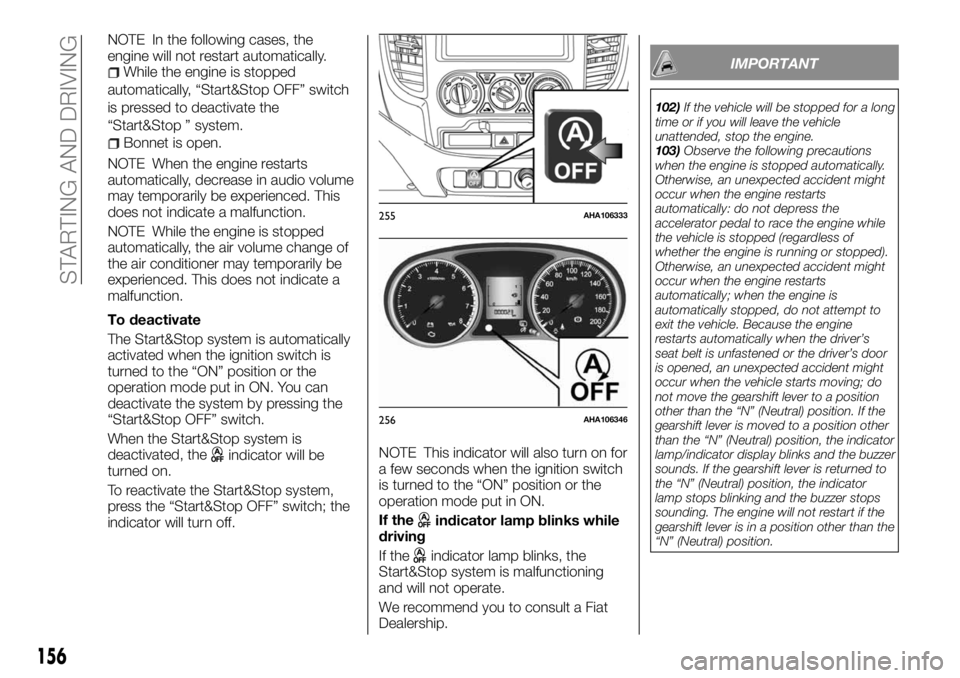
NOTE In the following cases, the
engine will not restart automatically.
While the engine is stopped
automatically, “Start&Stop OFF” switch
is pressed to deactivate the
“Start&Stop ” system.
Bonnet is open.
NOTE When the engine restarts
automatically, decrease in audio volume
may temporarily be experienced. This
does not indicate a malfunction.
NOTE While the engine is stopped
automatically, the air volume change of
the air conditioner may temporarily be
experienced. This does not indicate a
malfunction.
To deactivate
The Start&Stop system is automatically
activated when the ignition switch is
turned to the “ON” position or the
operation mode put in ON. You can
deactivate the system by pressing the
“Start&Stop OFF” switch.
When the Start&Stop system is
deactivated, the
indicator will be
turned on.
To reactivate the Start&Stop system,
press the “Start&Stop OFF” switch; the
indicator will turn off.NOTE This indicator will also turn on for
a few seconds when the ignition switch
is turned to the “ON” position or the
operation mode put in ON.
If the
indicator lamp blinks while
driving
If the
indicator lamp blinks, the
Start&Stop system is malfunctioning
and will not operate.
We recommend you to consult a Fiat
Dealership.
IMPORTANT
102)If the vehicle will be stopped for a long
time or if you will leave the vehicle
unattended, stop the engine.
103)Observe the following precautions
when the engine is stopped automatically.
Otherwise, an unexpected accident might
occur when the engine restarts
automatically: do not depress the
accelerator pedal to race the engine while
the vehicle is stopped (regardless of
whether the engine is running or stopped).
Otherwise, an unexpected accident might
occur when the engine restarts
automatically; when the engine is
automatically stopped, do not attempt to
exit the vehicle. Because the engine
restarts automatically when the driver’s
seat belt is unfastened or the driver’s door
is opened, an unexpected accident might
occur when the vehicle starts moving; do
not move the gearshift lever to a position
other than the “N” (Neutral) position. If the
gearshift lever is moved to a position other
than the “N” (Neutral) position, the indicator
lamp/indicator display blinks and the buzzer
sounds. If the gearshift lever is returned to
the “N” (Neutral) position, the indicator
lamp stops blinking and the buzzer stops
sounding. The engine will not restart if the
gearshift lever is in a position other than the
“N” (Neutral) position.
255AHA106333
256AHA106346
156
STARTING AND DRIVING
Page 159 of 312
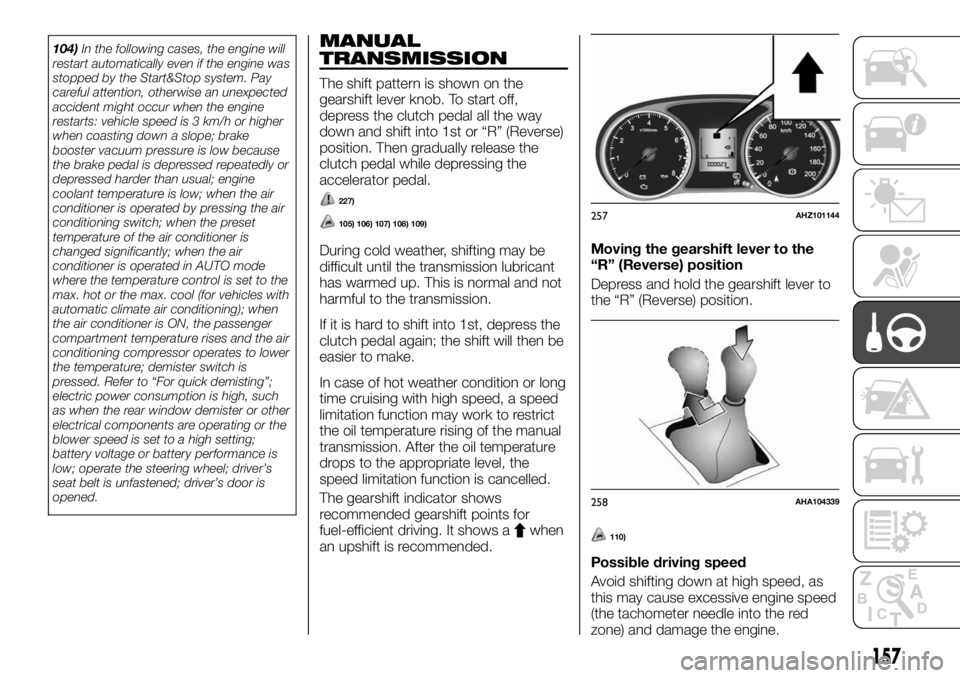
104)In the following cases, the engine will
restart automatically even if the engine was
stopped by the Start&Stop system. Pay
careful attention, otherwise an unexpected
accident might occur when the engine
restarts: vehicle speed is 3 km/h or higher
when coasting down a slope; brake
booster vacuum pressure is low because
the brake pedal is depressed repeatedly or
depressed harder than usual; engine
coolant temperature is low; when the air
conditioner is operated by pressing the air
conditioning switch; when the preset
temperature of the air conditioner is
changed significantly; when the air
conditioner is operated in AUTO mode
where the temperature control is set to the
max. hot or the max. cool (for vehicles with
automatic climate air conditioning); when
the air conditioner is ON, the passenger
compartment temperature rises and the air
conditioning compressor operates to lower
the temperature; demister switch is
pressed. Refer to “For quick demisting”;
electric power consumption is high, such
as when the rear window demister or other
electrical components are operating or the
blower speed is set to a high setting;
battery voltage or battery performance is
low; operate the steering wheel; driver’s
seat belt is unfastened; driver’s door is
opened.MANUAL
TRANSMISSION
The shift pattern is shown on the
gearshift lever knob. To start off,
depress the clutch pedal all the way
down and shift into 1st or “R” (Reverse)
position. Then gradually release the
clutch pedal while depressing the
accelerator pedal.
227)
105) 106) 107) 108) 109)
During cold weather, shifting may be
difficult until the transmission lubricant
has warmed up. This is normal and not
harmful to the transmission.
If it is hard to shift into 1st, depress the
clutch pedal again; the shift will then be
easier to make.
In case of hot weather condition or long
time cruising with high speed, a speed
limitation function may work to restrict
the oil temperature rising of the manual
transmission. After the oil temperature
drops to the appropriate level, the
speed limitation function is cancelled.
The gearshift indicator shows
recommended gearshift points for
fuel-efficient driving. It shows a
when
an upshift is recommended.Moving the gearshift lever to the
“R” (Reverse) position
Depress and hold the gearshift lever to
the “R” (Reverse) position.110)
Possible driving speed
Avoid shifting down at high speed, as
this may cause excessive engine speed
(the tachometer needle into the red
zone) and damage the engine.
257AHZ101144
258AHA104339
157
Page 160 of 312
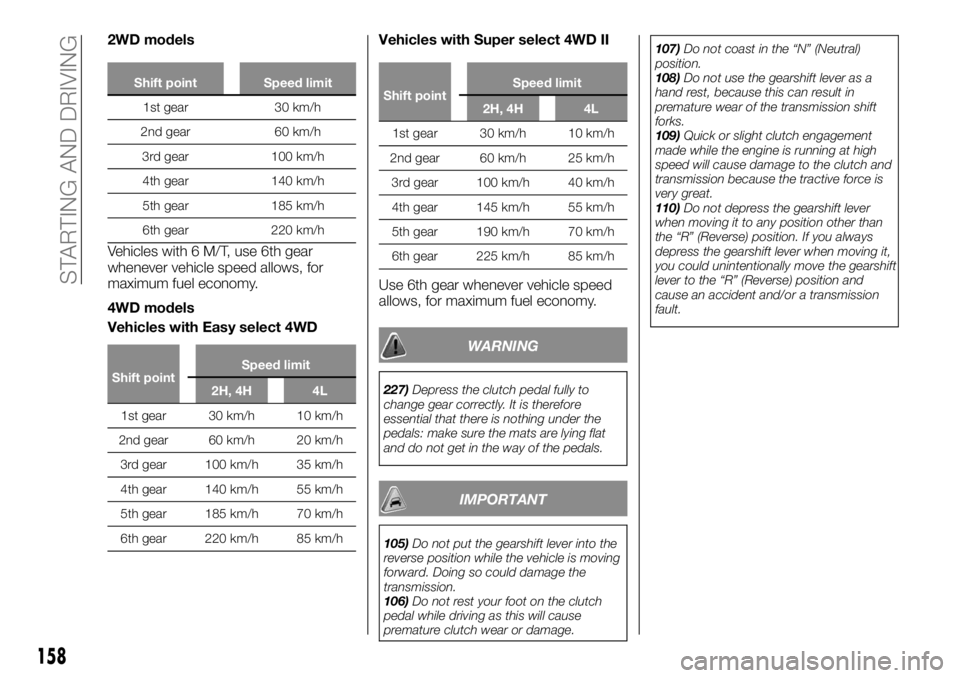
2WD models
Shift point Speed limit
1st gear 30 km/h
2nd gear 60 km/h
3rd gear 100 km/h
4th gear 140 km/h
5th gear 185 km/h
6th gear 220 km/h
Vehicles with 6 M/T, use 6th gear
whenever vehicle speed allows, for
maximum fuel economy.
4WD models
Vehicles with Easy select 4WD
Shift pointSpeed limit
2H, 4H 4L
1st gear 30 km/h 10 km/h
2nd gear 60 km/h 20 km/h
3rd gear 100 km/h 35 km/h
4th gear 140 km/h 55 km/h
5th gear 185 km/h 70 km/h
6th gear 220 km/h 85 km/h
Vehicles with Super select 4WD II
Shift pointSpeed limit
2H, 4H 4L
1st gear 30 km/h 10 km/h
2nd gear 60 km/h 25 km/h
3rd gear 100 km/h 40 km/h
4th gear 145 km/h 55 km/h
5th gear 190 km/h 70 km/h
6th gear 225 km/h 85 km/h
Use 6th gear whenever vehicle speed
allows, for maximum fuel economy.
WARNING
227)Depress the clutch pedal fully to
change gear correctly. It is therefore
essential that there is nothing under the
pedals: make sure the mats are lying flat
and do not get in the way of the pedals.
IMPORTANT
105)Do not put the gearshift lever into the
reverse position while the vehicle is moving
forward. Doing so could damage the
transmission.
106)Do not rest your foot on the clutch
pedal while driving as this will cause
premature clutch wear or damage.107)Do not coast in the “N” (Neutral)
position.
108)Do not use the gearshift lever as a
hand rest, because this can result in
premature wear of the transmission shift
forks.
109)Quick or slight clutch engagement
made while the engine is running at high
speed will cause damage to the clutch and
transmission because the tractive force is
very great.
110)Do not depress the gearshift lever
when moving it to any position other than
the “R” (Reverse) position. If you always
depress the gearshift lever when moving it,
you could unintentionally move the gearshift
lever to the “R” (Reverse) position and
cause an accident and/or a transmission
fault.
158
STARTING AND DRIVING